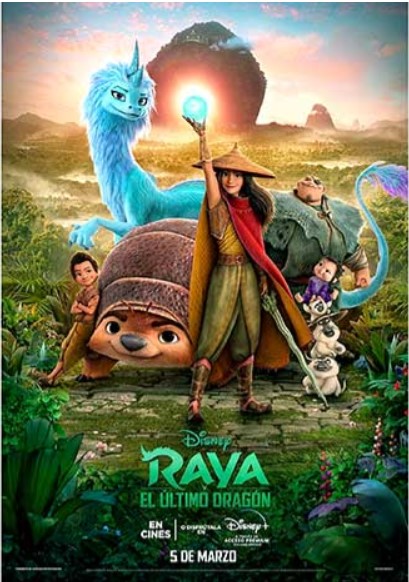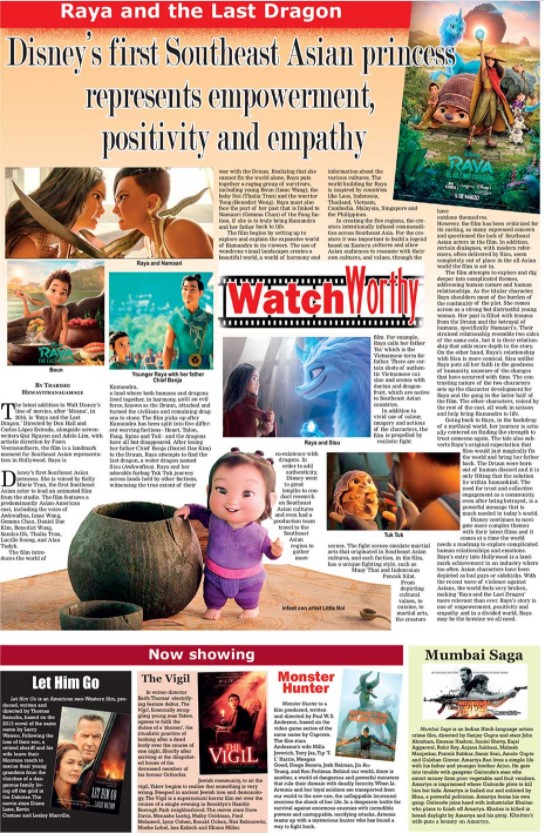Disney’s first Southeast Asian princess represents empowerment, positivity and empathy-By Tharishi Hewavithanagamage

Source:Island
The latest addition to Walt Disney’s line of movies, after ‘Moana’, in 2016, is ‘Raya and the Last Dragon.’ Directed by Don Hall and Carlos López Estrada, alongside screenwriters Qui Nguyen and Adele Lim, with artistic direction by Fawn Veerasunthorn, the film is a landmark moment for Southeast Asian representation in Hollywood. Raya is
Disney’s first Southeast Asian princess. She is voiced by Kelly Marie Tran, the first Southeast Asian actor to lead an animated film from the studio. The film features a predominantly Asian-American cast, including the voice of Awkwafina, Izaac Wang, Gemma Chan, Daniel Dae Kim, Benedict Wong, Sandra Oh, Thalia Tran, Lucille Soong, and Alan Tudyk.
The film introduces the world of Kumandra, a land where both humans and dragons lived together, in harmony, until an evil force, known as the Druun, attacked and turned the civilians and remaining dragons to stone. The film picks up after Kumandra has been split into five different warring factions – Heart, Talon, Fang, Spine and Tail – and the dragons have all but disappeared. After losing her father Chief Benja (Daniel Dae Kim) to the Druun, Raya attempts to find the last dragon, a water dragon named Sisu (Awkwafina). Raya and her adorable furbug Tuk Tuk journey across lands held by other factions, witnessing the true extent of their war with the Druun. Realizing that she cannot fix the world alone, Raya puts together a ragtag group of survivors, including young Boun (Izaac Wang), the baby Noi (Thalia Tran) and the warrior Tong (Benedict Wong). Raya must also face the part of her past that is linked to Namaari (Gemma Chan) of the Fang faction, if she is to truly bring Kumandra and her father back to life.
The film begins by setting up to explore and explain the expansive world of Kumandra to its viewers. The use of wondrous visual landscapes creates a beautiful world, a world of harmony and co-existence with dragons. In order to add authenticity, Disney went to great lengths to conduct research on Southeast Asian cultures and even had a production team travel to the Southeast Asian region to gather more information about the various cultures. The world building for Raya is inspired by countries like Laos, Indonesia, Thailand, Vietnam, Cambodia, Malaysia, Singapore and the Philippines.
In creating the five regions, the creators intentionally infused commonalities across Southeast Asia. For the creators it was important to build a legend based on Eastern cultures and allow Asian audiences to resonate with their own cultures, and values, through the film. For example, Raya calls her father ‘Ba’ which is the Vietnamese term for father. There are certain shots of authentic Vietnamese cuisine and scenes with durian and dragonfruit, which are native to Southeast Asian countries.
In addition to vivid use of colour, imagery and actions of the characters, the film is propelled by realistic fight scenes. The fight scenes emulate martial arts that originated in Southeast Asian cultures, and each faction, in the film, has a unique fighting style, such as Muay Thai and Indonesian Pencak Silat. From depicting cultural values, to cuisine, to martial arts, the creators have outdone themselves. However, the film has been criticized for its casting, as many expressed concern and questioned the lack of Southeast Asian actors in the film. In addition, certain dialogues, with modern references, often delivered by Sisu, seem completely out of place in the all-Asian world the film is set in.
The film attempts to explore and dig deeper into complicated themes, addressing human nature and human relationships. As the titular character, Raya shoulders most of the burden of the continuity of the plot. She comes across as a strong but distrustful young woman. Her past is filled with trauma from the Druun and the betrayal of humans, specifically Namaari’s. Their strained relationship resemble two sides of the same coin, but it is their relationship that adds more depth to the story. On the other hand, Raya’s relationship with Sisu is more comical. Sisu unlike Raya puts all her faith in the goodness of humanity, unaware of the changes that have occurred with time. The contrasting nature of the two characters sets up the character development for Raya and the gang in the latter half of the film. The other characters, voiced by the rest of the cast, all work in unison and help bring Kumandra to life.
Going back to Raya, in the backdrop of a mythical world, her journey is actually centered on finding the strength to trust someone again. The tale also subverts Raya’s original expectation that Sisu would just magically fix the world and bring her father back. The Druun were born out of human discord and it is only fitting that the solution lie within humankind. The need for trust and collective engagement as a community, even after being betrayed, is a powerful message that is much needed in today’s world.
Disney continues to navigate more complex themes with their latest films and it comes at a time the world needs a roadmap to explore complicated human relationships and emotions. Raya’s entry into Hollywood is a landmark achievement in an industry where too often Asian characters have been depicted as bad guys or sidekicks. With the recent wave of violence against Asians, the world feels very broken, making ‘Raya and the Last Dragon’ more relevant than ever. Raya’s story is one of empowerment, positivity and empathy and in a divided world, Raya may be the heroine we all need.








